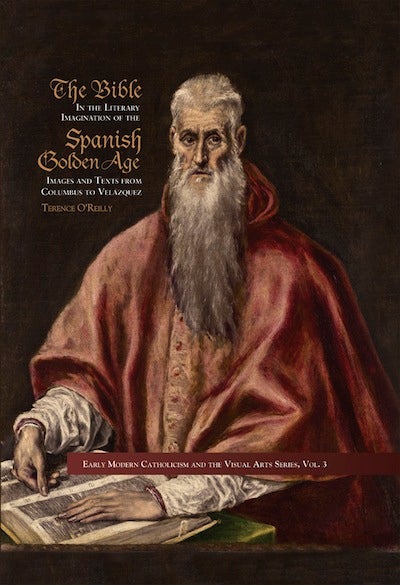
Bible in the Literary Imagination of the Spanish Golden Age, The
Price: $65.00
Place Published: Philadelphia
Publisher: Saint Joseph's University Press
Date Published: 2010
ISBN: 9780916101633
Book ID: 41
Description:
Early Modern Catholicism and the Visual Arts Series, Vol. 3
262 pages + preface, introduction, bibliography, and index | 10.25 x 7.25 inches | 53 color and b/w images
The biblical culture of the Spanish Golden Age, in both its learned and popular aspects, has not received the attention it deserves, partly because of the received view, rooted in sixteenth-century polemic, that during the siglo de oro the level of biblical knowledge in Spain was generally low. This lacuna in scholarship has tended in turn to obscure the impact of the Bible on the literary imagination of early modern Spain. The present book draws attention to the distinctive ways in which knowledge of the Bible was acquired, interpreted, and transmitted during the Golden Age, and it argues that in order to appreciate and understand the literature and art of the period it is necessary to bear them in mind. It considers in detail a selection of famous texts and paintings which assume, in different ways, a reader (or viewer) who is sensitive to biblical images, motifs and themes, and it shows how enigmatic features in the works concerned appear in a new light once the biblical allusions that inform them have been recognized. The works selected are of interest in their own right, but together they represent a cross-section of the genres that flourished in the Golden-Age Spain: accounts by travelers and explorers (the Diary of Columbus's First Voyage); narrative fiction (Amadís de Gaula, Lazarillo de Tormes, Persiles y Sigismunda, El Criticón); biblical exegesis (the Libro de profecías of Columbus; the scriptural commentaries of Arias Montano, Luis de León, Juan Maldonado, Francisco de Toledo); poetry (the Cántico espiritual of St. John of the Cross, the Ode on the Ascension of Fray Luis de León, the Soledad Primera of Luis de Góngora); drama (El condenado por desconfiado, attributed to Tirso de Molina); and painting (the biblical bodegones of Diego de Velázquez and their literary and iconographic contexts).
The Bible in the Literary Imagination of the Spanish Golden Age brings together recent and current research in two distinct fields. On the one hand, specialist studies of the famous literary texts and paintings selected for detailed analysis (the secondary literature is in each case extensive). On the other, critical editions and studies of the religious writings by which biblical knowledge was disseminated: devotional and spiritual texts (e.g., the obras of Ignatius Loyola, Juan de Avila, Alonso de Orozco, Luis de Granada), and biblical exegesis (e.g., the commentaries of Cipriano de la Huerga, Luis de León, Arias Montano). Both fields of scholarship have flourished in modern Spain, but usually in independence of each other. O'Reilly's book breaks new ground by making connections between them.
The author writes with three types of reader in mind. The Bible in the Literary Imagination of the Spanish Golden Age will be of interest to academic hispanists who specialize in the literature of the Golden Age. It should also appeal to undergraduate and postgraduate students of Spanish literature and art. With their needs in mind, it has been written in a clear and jargon-free style, and the argument is supported at every stage by illustrations drawn from printed books and paintings of the period. It will therefore be accessible too to general readers who are interested in the subject matter but relatively uninformed.
Publication of the book was assisted by a grant from the Program for Cultural Cooperation between Spain's Ministry of Culture and United States Universities.
Terence O'Reilly is professor emeritus of Hispanic Studies at University College Cork (Ireland). He is the author/editor of a half-dozen books, including From Ignatius Loyola to John of the Cross: Spirituality and Literature in Sixteenth-Century Spain (Ashgate, 1995). He has published eighteen articles in scholarly journals and more than that number of essays/chapters in books. Dr. Reilly was recently honored by being presented Ars Eloquentiae: Studies on Early Modern Poetry and Art in Honour of Terence O'Reilly, ed. Barry Taylor and Isabel Torres (a special issue of the Bulletin of Hispanic Studies [Liverpool] 86/6 [2009]). In their appreciation introducing this volume, the editors note: "Reviewers of Terry's work have been unanimous in their praise, finding his prose 'graceful'; his arguments 'judicious'; his approach 'sensitive' and 'balanced'; his conclusions 'illuminating' but 'unpretentious'; and his analyses all the more eloquent when 'untangling the threads of controversy.'"
CRITICAL ACCLAIM
"O'Reilly, a scholar of Spanish Golden Age religion and the arts, articulates in his book what can be termed a new method of biblical reception history; he acknowledges the different levels--latinate and vernacular--of biblical literacy that authors and audiences held in common and posits that no intellectual history of any piece of literature or art in the early modern era is complete without attention to its biblical sources."
Jessica A. Boon, Sixteenth Century Journal
"The study of the reception of the Bible has become fashionable, but one rarely sees such a substantial contribution as this volume. [...] This volume is a treasure and deserves a wide audience. The publisher is to be commended for bringing this remarkable book about the literary imagination of the Bible to public attention and giving it such an exquisite layout with numerous illustrations."
Ulrich L. Lehner, Theological Studies
"The Bible in the Literary Imagination of the Spanish Golden Age offers a beautifully illustrated exploration of the direct and indirect use of the Bible in art from the time of Columbus (1451-1506) to the work of the painter Diego Velázquez (1599-1660). [...] Terence O'Reilly is to be congratulated for opening up an important field of inquiry that traverses both the literary culture and spirituality of the Golden Age. His work is based on solid scholarship that is relevant and beautifully presented in this very fine volume."
Renata Furst, Spiritus: A Journal of Christian Spirituality



